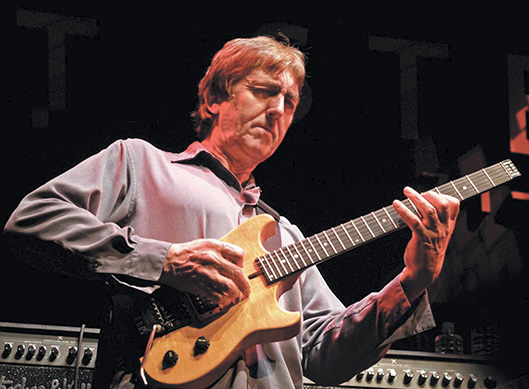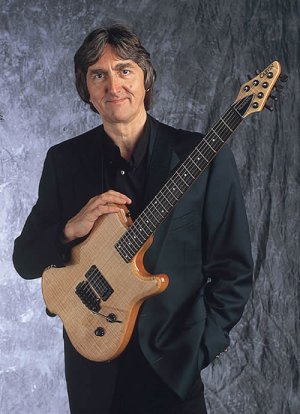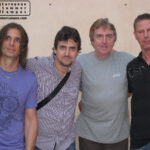The sounds of Django Reinhardt, Jimmy Rainey, Charlie Christian, Joe Pass, Eric Clapton, and John Coltrane were among this English musician’s early inspirations when he began to work professionally as a musician in his early twenties.
Born on August 6, 1945 in the city of Bradford, England, Holdsworth had been extensively tutored in aspects of musical theory and jazz appreciation by his father, an accomplished amateur musician. Holdsworth paid his musician’s dues early on working the dance-club circuit, where he began to meet fellow musicians who hailed from the south. One of England ‘s best jazz tenor saxophonists, Ray Warleigh, heard amazing potential in Holdsworth’s playing and brought him along to participate in jazz sets at the onset of the 70s, including sessions with Ray at Ronnie Scotts in London.
Holdsworth first recorded in 1969 with the band ‘Igginbottom on their lone release, “‘Igginbottom’s Wrench” (later reissued under the group name of “Allan Holdsworth & Friends”). In 1971 he joined Sunship, an improvisational band featuring keyboardist Alan Gowen, future King Crimson percussionist Jamie Muir and bassist Laurie Baker; they played live but never released any recorded material. Next came a brief stint with jazz rock band Nucleus, with whom Holdsworth played on their 1972 album, “Belladonna”. Holdsworth’s career brought him to international audiences suddenly in the early 1970s, when he joined drummer John Hiseman’s short-lived but much acclaimed progressive rock band, Tempest. A decade later, Tempest vocalist Paul Williams would team up with Holdsworth again to form Holdsworth’s IOU band and create their independently-released debut recording, which prompted Holdsworth to move his home from London to Southern California .
Holdsworth’s career throughout the 70s saw a series of feast-or-famine periods all too familiar to many of the most talented musicians. By 1975 Holdsworth had developed a reputation as one of England ‘s best, underrated guitarists in what was then the avant-garde of English instrumental music ensembles, the legendary group, Soft Machine. Holdsworth’s trademark sound is evident with a technique that routinely soars with supersonic intensity, and one of its earliest available samplings can be heard on the 1974 Soft Machine studio release, “Bundles” . While his reputation in Soft Machine attracted international audiences, he also gained the attention of one of jazz’s greatest drummers, the late Tony Williams, known for his pivotal role in bringing Miles Davis to explore rock-based riffs and motifs in an improvisational context. Holdsworth recorded on one of the most celebrated fusion albums from the mid-70s, “Believe It”, (Epic), as a member of the Tony Williams’ New Lifetime. This marked the beginning of Holdsworth’s career as a legendary journeyman, but one rarely performing before U.S. audiences. 
Between 1976 and 1978 Holdsworth’s guitar sounds and solos emerged as a mesmerizing tour de force and he participated in many of that era’s landmark jazz-fusion and instrumental rock recordings by Jean Luc Ponty (“Enigmatic Ocean”), Gong (“Gazeuse!”), and Bill Bruford (“Feels Good to Me”, “One of a Kind”). Late in the 70s, the once dominant genre of classic British “prog rock” stumbled on unsure footing as the punk and new wave bands rose in commercial prominence. Drummer Bill Bruford, a founding member of Yes who later joined King Crimson, suggested Holdsworth participate in a new project featuring the formidable rhythm section of King Crimson and a brilliant young violinist/keyboardist Eddie Jobson, who had worked with both Frank Zappa and Roxy Music. The resulting debut album, “U.K .” , became what was later considered the last and greatest milestones of 70s progressive rock. The band’s sound was at the time both technically and artistically at the cutting edge of rock music, given the coupling of Jobson’s innovative use of synthesizers and electric violins, coupled with Holdsworth’s unconventional chord voicings, searing solos, and passionate melodic phrases. The U.K. superband setting was as brilliant as it was short-lived, and egos and questions of creative direction led to a split between Bruford and Holdsworth on one side, and Jobson and bassist John Wetton on the other. In 1996 Guitar World cited Holdsworth’s contribution to U.K . as the factor in naming it one of the top 10 rock guitar albums “of all time.”
In 1978, Holdsworth decided he wanted to pursue a different, more live-based direction as opposed to his recent participation in lush, studio-crafted masterpieces. He sought out a more immediate, less intricately arranged band context than what had been established with Bruford, in order to explore a rock-oriented musical context that also explored extended instrumental ensemble improvisations. Holdsworth wanted to rediscover some of the energy and dynamics that had been so memorable in his live performances working with Tony Williams, and reluctantly parted company with Bruford’s band. Holdsworth began to develop his own trio with two other Northern English musicians, drummer Gary Husband, and bassist Paul Carmichael, which begun Holdsworth’s first touring band as a leader, the now-celebrated I.O.U. band. Their first recording “I.O.U.” sold exceptionally well for an independent release in 1982, and Holdsworth’s friend and admirer, guitarist Eddie Van Halen, proved instrumental in securing I.O.U. a recording contract with Warner Bros. Executive Producer Ted Templeman wanted to experiment with a “mini-album” concept, which resulted in the 1984 Grammy-nominated release, “Road Games”, which featured vocal cameos from long-time Holdsworth collaborator, the legendary Jack Bruce. It also featured a new American line-up, with Jeff Berlin and Chad Wackerman comprising the rhythm section. However tensions with the label over creative control led to a split between Holdsworth and Warner Bros. In 1985 Holdsworth signed with the Enigma label, enjoying creative control, and Jimmy Johnson joined the group after Jeff Berlin’s departure to pursue his solo career. Holdsworth then recruited one of the most respected L.A. session bassists, Jimmy Johnson, leader of Flim and the BBs. The last version of the I.O.U. band went back in the studio and with some notable guest appearances (among them bassist Gary Willis and original I.O.U. drummer Gary Husband) contributed to tracks for the highly successful release, “Metal Fatigue” (1985).
In 1986 the release of “Atavachron”, his fourth studio album, demonstrated Holdsworth’s focus on instrumental music, continuing his core band with Johnson and Wackerman. We can hear a use of a brand new instrument named the SynthAxe. This unusually designed MIDI controller (different from a guitar synthesizer) would become a staple of Holdsworth’s playing for the rest of his recording career, during which he would effectively become the public face of the instrument. “Atavachron” also featured stellar guest appearances by two of Southern California ‘s most sought after jazz keyboardists, Alan Pasqua and Billy Childs. Like other Holdsworth recordings to follow, it proved to be a summit for great drummers, with guest contributions from Tony Williams and Gary Husband. Husband’s increasingly successful career eventually led to Holdsworth’s appearance as a studio musician and band member with Level 42 for their 1993 release, “Guaranteed”.
The follow-up to “Atavachron”, “Sand” (1988), marked a new period with Holdsworth concentrating on his exploration of the SynthAxe and featured no vocal work. Holdsworth received the winning award in Guitar Player Magazine’s poll as “best guitar synthesist,” for many consecutive years afterward. With “Secrets” (1990) Holdsworth returned to his association with Enigma records, (which became the Restless label) featuring an album recorded mostly with the great session drummer Vinnie Collaiuta, who later joined Sting’s band and had previously worked with Frank Zappa and Jeff Berlin. “Secrets” further revealed Holdsworth’s rich harmonic vision and unleashed more distinctively “Holdsworthian” music, an enigmatic style that continues to invert, push, and transform the boundaries of more conventional rock, fusion, and jazz forms.
During this period the keyboardist from Stanley Clarke’s touring band, Steve Hunt, joined Holdsworth’s band. In the early 90s, Holdsworth also appeared in a jazz superband and at festivals with other great jazz and fusion legends, including Stanley Clarke, Billy Cobham, and Michael and Randy Brecker among others.
A collaboration in 1990 with fusion guitarist Frank Gambale came about in the form of Truth in Shredding, an ambitious collaborative project put together by Mark Varney through his Legato Records label.
1992’s “Wardenclyffe Tower” furthered an exploration of Holdsworth’s own designs for baritone electric guitars (built by luthier Bill DeLap) and broadened the use of his chordal orchestrations and solo phrasings via the SynthAxe.
 In 1994, “Hard Hat Area” was released on Restless with the latest version of Holdsworth’s band, including Icelandic bassist Skull Sverrisson, Gary Husband, and Steve Hunt, providing one of his most satisfying projects from the quality of group interplay and capturing the band closer to its live performance context.
In 1994, “Hard Hat Area” was released on Restless with the latest version of Holdsworth’s band, including Icelandic bassist Skull Sverrisson, Gary Husband, and Steve Hunt, providing one of his most satisfying projects from the quality of group interplay and capturing the band closer to its live performance context.
A collaboration in 1996 with brothers Anders and Jens Johansson resulted in “Heavy Machinery”, an album with more hard-edged playing from Holdsworth than was usual. In the same year Holdsworth released “None Too Soon”, marked by a departure in style from this impressive string of previous group projects. It provided Holdsworth the opportunity to showcase his interpretation of some classic jazz standards and several originals by one of England ‘s best-known jazz pianists, Gordon Beck. Holdsworth recorded some of his favorite, lesser-known jazz standards, along with several Gordon Beck originals, in a “straight-ahead” jazz vein, drawing upon Beck’s talents as an arranger. The rhythm section teamed for the project included bass prodigy Gary Willis and drummer Kirk Covington, both members of the West Coast based fusion powerhouse, Tribal Tech. “None Too Soon” built upon the same chemistry established in a brief recording session of the same musicians featured on a Beatles guitar tribute titled “Come Together,” (1994, NYC Records) in which this same group covered Beck’s arrangement of the Beatles’ “Michelle.”
In “None Too Soon”, Holdsworth produced a refreshing jazz recording that realized a different perspective on his playing, while demonstrating his appreciation of standards as penned by John Coltrane, Bill Evans, Django Reinhardt and Joe Henderson. “None Too Soon” offers listeners a compelling and swinging musical journey, including a riveting, updated interpretation of Irving Berlin’s “How Deep Is the Ocean” and a blistering twist on the Lennon/McCartney classic, “Norwegian Wood.”
Building on the supreme sonic craftsmanship Holdsworth realizes in his home studio in Southern California, The Brewery, Holdsworth’s latest solo recording is certain to be singled out as one of his greatest musical masterpieces. “The Sixteen Men of Tain” marks a further exploration of traditional jazz motifs, and, as a first on his solo projects, an acoustic rhythm section. Holdsworth’s tenth solo album marked the debut of a new band formed with bassist Dave Carpenter and drummer Gary Novak, both West Coast session men. First released in 2000, a special edition with two additional tracks was released via Eddie Jobson’s label, Globe Music, in summer of 2003. “Tain” marked a new direction in a forward-looking jazz vein and blended together a new vision explored to a degree in the more traditional jazz arrangements found in “None Too Soon”.
One frequent topic of discussion among Holdsworth devotees was the fact that after well over a decade of touring with stellar players, Holdsworth had never approved the release of any live recordings by his bands, or any of those with him as a guest performer for that matter. In Fall 2002, Sony Japan released Holdsworth’s first ever live recording, featuring Jimmy Johnson and Chad Wakerman in which Sony featured the trio’s performance show as a showpiece for their next generation of state-of-the-art five-channel sound technology. In late 2003, Alternity Records will release a second landmark Holdsworth live recording, “Then!” featuring a quartet performance from 1990 with keyboardist Steve Hunt, along with original I.O.U. drummer Gary Husband, and Jimmy Johnson. Recorded originally in digital 24-track, “Then!” covers material from a broad swath of Holdsworth’s recording career, from his days with Tony Williams’ “Lifetime” up through “Hard Hat Area” and includes three never-released group improvisation tracks, not to mention some of Holdsworth’s most powerful and ferocious solo flights ever captured on tape. Holdsworth spent time later in 2002 completing production duties for the Softworks album “Abracadabra”, which featured alumnus from different eras of the legendary English experimental band, Soft Machine. Holdsworth toured with the band in Japan in the summer of 2003, which included saxophonist Elton Dean, bassist Hugh Hopper, and drummer John Marshall.
His eleventh album, “Flat Tire: Music for a Non-Existent Movie”, was released in 2001. It is a very uniquely rewarding listening experience that puts a full stop to the studio releases, although he claimed in 2010 to have enough material for two albums, which he planned to begin recording after a show in Tel Aviv.
Throughout the latter half of the 2000s he toured both North America and Europe, and played as a guest on albums by numerous artists, like the keyboardist Derek Sherinian’s 2004 album “Mythology”, as well as with the latter’s progressive metal supergroup Planet X, on their 2007 album “Quantum”.
In 2006 he performed with keyboardist Alan Pasqua, Wackerman and bassist Jimmy Haslip as part of a live tribute act in honour of the late Tony Williams, with whom Holdsworth and Pasqua had played in the mid-1970s; a DVD (“Live at Yoshi’s”) and double album (“Blues for Tony”) of this tour were released in. Throughout 2008–10 he toured with drummers Terry Bozzio and Pat Mastelotto, and bassist Tony Levin as HoBoLeMa, a supergroup playing improvised experimental music. On 3 November 2011, Holdsworth performed in Mumbai as part of drummer Virgil Donati’s touring band. The following year, Holdsworth joined Chad Wackerman for a third time on a studio album by the latter, for “Dreams Nightmares and Improvisations”.
In 2015, Holdsworth launched a PledgeMusic venture to release new studio material, as part of a collection named “Tales from the Vault”. The album appeared in July 2016. It collects old, discarded recordings rescued from the cutting room floor and refurbished for release, along with a couple of completely new tracks.
Holdsworth died from high blood pressure on April 15, 2017. According to The Guardian, he played his final gig in San Diego on April 10, 2017.
Manifesto Records has released three posthumous albums as of 2020. All are archival live recordings. “Live in Japan 1984”, released in 2018, is the first authorized release of the widely bootlegged “Tokyo Dream” laserdisc, with a limited edition bonus DVD. “Warsaw Summer Jazz Days ’98”, released in 2019, contains a CD and DVD of a concert that was originally broadcast on Polish TV. 2020 saw the release of “Frankfurt ’86”, a CD and DVD of Holdsworth’s 1986 appearance at the Deutsches Jazz Festival.
Holdsworth also appears on two tracks on German artist MSM Schmidt’s 2017 album “Life”, his latest studio recordings to be released as of 2019. Peter Lemer released the album “Jet Yellow” in 2019, featuring Holdsworth on the track “Dognose”. This album was however recorded in 1977.
In the past decade Holdsworth has varied his music career, engineering and inventing electronic sound-processing tools, including The Harness. He has several unique electric guitar designs now produced by Carvin, and has worked with luthier DeLap in conceiving custom baritone and piccolo guitars. In fact one of the larger and longer baritones is featured on all three improvised pieces in the new live album, “Then!”
Whether he is playing instruments with the latest electric guitar innovations, piccolo, baritone guitars, or the Synthaxe, Holdsworth remains never quite satisfied in his eternal “quest for the perfect tone.”











